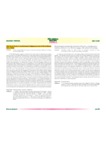Please use this identifier to cite or link to this item:
http://www.alice.cnptia.embrapa.br/alice/handle/doc/1071149Full metadata record
| DC Field | Value | Language |
|---|---|---|
| dc.contributor.author | LANZA, T. R. | pt_BR |
| dc.contributor.author | MING, L. C. | pt_BR |
| dc.contributor.author | HAVERROTH, M. | pt_BR |
| dc.contributor.author | FERREIRA, A. B. | pt_BR |
| dc.date.accessioned | 2017-06-20T11:11:11Z | pt_BR |
| dc.date.available | 2017-06-20T11:11:11Z | pt_BR |
| dc.date.created | 2017-06-20 | pt_BR |
| dc.date.issued | 2017 | pt_BR |
| dc.identifier.citation | In: ANNUAL MEETING OF THE SOCIETY FOR ECONOMIC BOTANY, 58., 2017, Bragança. Living in a global world: local knowledge and sustainability: book of abstracts. Bragança: Instituto Politécnico de Bragança: Centro de Investigação de Montanha: Society for Economic Botany, 2017. | pt_BR |
| dc.identifier.uri | http://www.alice.cnptia.embrapa.br/alice/handle/doc/1071149 | pt_BR |
| dc.description | The objective of the present study was the study of wild food plants used in the five villages of TI Kaxinawá of Nova Olinda (TIKNO), located in the municipality of Feijó, Acre, Brazil. TIKNO covers an area of approximately 28,000 hectares, on the banks of the Envira River, with a total population of 492 inhabitants. The methodology used was free listing and walking in the woods with different indigenous representatives. | pt_BR |
| dc.language.iso | eng | eng |
| dc.rights | openAccess | eng |
| dc.subject | Conhecimento tradicional | pt_BR |
| dc.subject | Terra Indígena Kaxinawá de Nova Olinda (TIKNO) | pt_BR |
| dc.subject | Feijó (AC) | pt_BR |
| dc.subject | Acre | pt_BR |
| dc.subject | Amazônia Ocidental | pt_BR |
| dc.subject | Western Amazon | pt_BR |
| dc.subject | Amazonia Occidental | pt_BR |
| dc.subject | Plantas silvestres | pt_BR |
| dc.subject | Recursos florestais | pt_BR |
| dc.subject | Conocimiento tradicional | pt_BR |
| dc.subject | Consumo alimentario | pt_BR |
| dc.subject | Recursos forestales | pt_BR |
| dc.title | Wild food plants in the Kaxinawá Indigenous Land of Nova Olinda, Acre, Brazil. | pt_BR |
| dc.type | Resumo em anais e proceedings | pt_BR |
| dc.date.updated | 2017-06-20T11:11:11Z | pt_BR |
| dc.subject.thesagro | Etnobotânica | pt_BR |
| dc.subject.thesagro | Planta silvestre | pt_BR |
| dc.subject.thesagro | Consumo alimentar | pt_BR |
| dc.subject.thesagro | Agricultura de Subsistência | pt_BR |
| dc.subject.nalthesaurus | Forest resources | pt_BR |
| dc.subject.nalthesaurus | Subsistence farming | pt_BR |
| dc.subject.nalthesaurus | Indigenous knowledge | pt_BR |
| dc.subject.nalthesaurus | Wild plants | pt_BR |
| dc.subject.nalthesaurus | Food consumption | pt_BR |
| dc.format.extent2 | 1 p. | pt_BR |
| riaa.ainfo.id | 1071149 | pt_BR |
| riaa.ainfo.lastupdate | 2017-06-20 | pt_BR |
| dc.contributor.institution | Tomaz Ribeiro Lanza, Unesp; Lin Chau Ming, Unesp; MOACIR HAVERROTH, CPAF-Acre; Almecina Balbino Ferreira, Unesp. | pt_BR |
| Appears in Collections: | Resumo em anais de congresso (CPAF-AC)  | |










